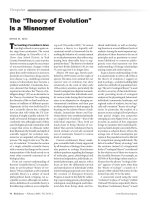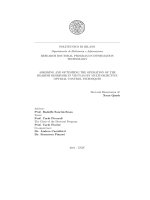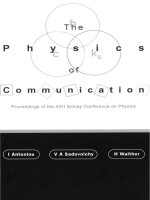Chapter 8: The Operation of Batteries doc
Bạn đang xem bản rút gọn của tài liệu. Xem và tải ngay bản đầy đủ của tài liệu tại đây (412.04 KB, 14 trang )
8
The Operation of Batteries
U C. STAHL
8.1 INTRODUCTION
This chapter discusses aspects of the use of stationary batteries within the Deutsche
Telekom AG. The names Deutsche Telekom or Telekom shall be used, although the
responsibility for the area power supply for telecommunication networks was
transferred to the Deutsche Telekom Immobilien und Service GmbH, (De Te
Immobilien), a 100% subsidiary company of the Telekom, since January 1, 1996. At
present, the DeTe Immobilien takes care of approximately 12,000 power supplies
with a capacity overall of nearly 22 million Ah.
In the area of the Deutsche Telekom, most different battery systems are as
shown in Figure 8.1. Primary batteries mainly are used in measuring instruments.
Alkaline secondary batteries (accumulators) have a great importance in the area of
communication technology, such as on mobile phones as well as on cordless phones.
Still they are used as starter batteries for mobile network substitute installations
(generator sets).
Lead-acid batteries are used, for example, as
. Traction batteries in industrial trucks.
. Starter batteries for cars, heavy trucks, and stationary network substitute
installations.
. Stationary batteries in power supply installations for telecommunication
networks.
Copyright © 2003 by Expert Verlag. All Rights Reserved.
In Chapter 7 the series of the stationary batteries with Plante
´
plates, tubular plates,
and grid type plates as positive electrode are described in detail. In the following,
stationary batteries are discussed.
8.2 THE DEVELOPMENT OF POWER SUPPLY FOR
TELECOMMUNICATIONS
Batteries and telephones were developed in the first half of the 19th century. The
power supply of the telephone consisted at the beginning of its development of
primary batteries . Initially the batteries were placed in the telephone users’ facilities
and were called ‘‘Ortsbatterie’’ (stationary battery). In the course of further
development, the batteries, now accumulators or secondary batteries, were installed
in the central exchange office, in German im Amt, and therefore called
‘‘Amtsbatterie’’ (office battery). Until today the Amtsbatterie is retained from the
subscriber.
In the early phase of the Ortsbatterie, the function of the telephone was
dependent on the functionality of the battery at the subscriber’s facility. The
transition to the Amtsbatterie changed the situation in so far as an increasing
number of connected subscribers were affected in case of battery failure. The battery
became a central security element; continuous availability became necessary. Today,
subscribers are responsible for the functionality of their equipment again when
additional functions (cordless telephones, answering machines) are used which need
a local power supply.
The direct current voltage which is necessary for the function of telephones was
exclusively taken from a battery. When discharged by the consumer load by a switch
the battery was disconnected from the consumer load. A second battery, in the
meantime under charge, now was connected to the consumer load. The switch to the
charger now connected the discharged battery. With this operating mode, which is
Figure 8.1 Overview of the batteries in use within Deutsche Telekom.
Copyright © 2003 by Expert Verlag. All Rights Reserved.
called ‘‘change battery operation’’, the batteries had to perform a high number of
cycles.
With the onward development of the components as well as the co ntrol and
steering technology, the possibility was created to provide consumers with a voltage
derivative from the mains. That in parallel with the consumer-switched battery
guarantees interruption-free parallel operation (see Figure 8.2).
The telecommunication equipment , that essent ially consisted at this time of
relays, spools, electromechanical selectors, and valve amplifiers, had a current
demand dependent on conversation as characteristic. The current peaked on a ‘‘day
curve’’ in which the ratio between minimum and maximum amounted to 1:10. For a
long time the rectifiers were dimensioned so that the batteries were discharged if the
top current was demanded, and at low consumer current were loaded again. This
operating mode is called ‘‘boosting operation’’. The batteries assume an undefined
loading condition. Therefore only a part of the nominal capacity is disposable at a
mains failure. With the operating mode of stand-by parallel operation, the rectifiers
are dimensioned for the maximum current plus charging current, so that the battery
stands constantly in stand-by and will be discharged only in case of a mains failure.
The battery is here under float condition to equalize capacity losses by self-discharge.
The battery is always fully charged. The rectifier installations of the Deutsche
Telekom are so dimensioned that the batteries are discharged only in the case of
mains failure. This requirement on the battery postpones/avoids a high number of
cycles (change battery operation or boosting operation) to constant long-time
behavior under float condition.
Another important characteristic of the electromagnetic exchange technology
is a voltage with close tolerance required for the functionality. In order to fulfill this
demand, different circuits were applied, which guaranteed that the consumers were
not exposed to the full voltage range of the battery (especially the charge voltage).
The battery however always stood at disposal. Possible circuit varia nts are pick-up
technology (Figure 8.3) and counter-voltage technology (Figur e 8.4).
Figure 8.2 Power supply installation for parallel operation.
Copyright © 2003 by Expert Verlag. All Rights Reserved.
The principle of the circuit is based on the fact that at mains operation the
consumers are switched parallel only with a part of the battery, with 27 cells with a
60-V power supply. The main rectifier is adjusted to an output voltage that
corresponds to the float voltage of this part battery. The other cells get the charge
voltage from the additional rectifier. In the case of mains failure consumers are
switched with achievement of a corresponding voltage border to the total battery
while S1 closes; meanwhile S2 opens. The decoupling diode makes possible the
interruption-free switch.
With counter-voltage technology the entire battery gets the charge voltage of
the rectifier. The necessary voltage reduction is reached over diodes switched in
forward direction. With mains failure the diodes are bridged voltage dependent. In
the end, the consumers are switched to the battery directly parallel. The performance
moved by the diodes in heat causes poor efficiency.
The introduction of digit al exchange technology brought numerous changes;
among other things the output voltage of central power supply has a characteristic of
a transfer voltage. Consumers are supplied by DC/DC converters, which have a large
input voltage range. DC/DC converters are necessary because different voltages (5 V,
12 V, 27 V) are required for the function of the electronics of the exchange
equipment. Consequently, rectifiers, batteries, and consumers could now be switched
directly parallel, as shown in Figure 8.2.
The recharging after a mains failure is performed by a boost charge for a fixed
time period or with float voltage. With the application of the boost charge, the taken
energy is loaded more quickly into the battery again and is more quickly available
again. In addition, these batteries show batter long-time behavior than batteries
which were recharged under float conditions.
Figure 8.3 Power supply installation in the pick-up technology.
Figure 8.4 Power supply installation in counter-voltage technology.
Copyright © 2003 by Expert Verlag. All Rights Reserved.
With the decentralization of the exchange networks, separation of functional
units into the surface, as well as the use of glass fiber, beside the batteries in the
central office with high capacity, many batteries of inferior capacity had to be
installed.
8.3 PRODUCT DEVELOPMENT AND PRODUCTS IN USE
The products which are used by telecommunicati ons reflected the development of the
industry in the area of stationary batteries. Big users like Telekom immediately
tested many developments after the laboratory phase. The experience collected in
practical use was evaluated, and knowledge about it went back in into the battery
production. While in the early years of the central offices, batteries with Plante
´
plates
were used; these batteries were replaced by batteries with ‘‘narrow mounted’’ Plante
´
plates. In the beginning of the 1970s the use of stationary batteries with positive
tubular plates started. Stationary batteries with positive tubular plates of present
production, especially in the capacity area up to 3000 Ah, clearly differ from those
from the first production years. The container material hard rubber was replaced
with SAN and pole sealing was modified many times to eliminate leakages and
crevice corrosi on. Still the connections between pole and covers must be shaped so
that from plate growth resultant strengths cannot lead to rips in the covers or cover
detachment of the container. An essential alteration was the lowering the amount of
antimony of the plates. This was an advantage for the user because electrolyte loss
was drastically lowered and the cycles for supplementing the electrolyte could be
increased. In addition, an essential presupposition was created for the development
of valve-regulated batteries.
Valve-regulated batteries have been use at Deutsche Telekom since the end of
the 1980s. First these batteries were put into low scope purposes for testing. Their
use was forced strongly with the extension of telecommunications in the ‘‘new
countries’’ (area of the former GDR), so that today a pproximately 1700 locations
(mainly cell capacities of 200 Ah up to 1500 Ah) with valve-regulated batteries are
realized. Since these product series permi t the use of batteries in applications in
which the use of vented batteries is completely impossible, valve-regulated batteries
of small capacity (bloc batteries up to 65 Ah) are used today in most facilities. Main
focuses of use are converters for the transition from copper wires to glass fiber.
In the past the use of grid type batteries was restricted to operation tests. The
collected experiences did not meet the expected results. Today, these products are
more reliable in operation behavior; furthermore the use of grid type batteries is
necessary in numerous applications on the basis of the low inside resistance and the
good high current behavior.
To exchange equipment, peripheral facilities came with the introduction of
digital exchange technology, for example, computer, printer, and other hardware
components. This equipment needs mains without interrupt. To provide for these
facilities in individual cases DC/DC converters or, usually, uninterruptible power
supplies (UPS) are used . The UPS can be placed locally or centrally. The UPS are
used mainly in order to bridge over short mains failure as well as for realizing a
proper switch-off. Therefore the batteries in use must deliver a high current for a
short time. Batteries with grid type plates fulfill this requirement optimally.
Copyright © 2003 by Expert Verlag. All Rights Reserved.
Figure 8.5 gives an overview of the distribution of the series at the total stock.
It is to be heeded that batteries with capacities up to 100 Ah are not consider ed.
8.4 CONCEPT OF ENERGY RESERVE
The basis of the conception and dimension of the power supply of a location is the
‘‘concept of energy reserve’’ of the Deutsche Telekom. It includes commitments to
the general concept and the dimension of the components of the power supply on the
basis of local conditions, including, in parti cular (a) importance of the telecommu-
nication consumer , (b) power demands, and (c) attainability of the facility.
The importance of the telecommunication consumer depends on the
consequences of a failure of the power supply for the connected subscribers. The
importance is greater when more subscribers are affected by such failure, which
determines whether the failure has an effect na tionwide or only regionally. The
demands of the consumer with the highest importance are decisive if different
technical consumers are connected with a power supply.
The power demands of the consumer can be realized with a battery only for a
certain time because of the limited energy reserve. The use of network substitute
installations makes it possible to ensure a proper function even at long-lasting mains
failure. For consumers nationwide, the energy reserve concept presupposes the use of
network substitute installations on principle. With the introduction of digital
exchange technology, a concentration of the components became possible on a small
volume. The technology no longer used electromechanical components but pure
electronics that could be concentrated in fractions of the previous volume. The limit
of the concentration was the energy moved per volume and with it the loss
performance attacking as waste heat. A completely new problem assumed shape,
because the use of climate technology became necessary that had to be able to
operate also in the case of mains failure. Either a network substitute installation is
used or with smaller performances a battery supplies the DC/AC converter.
Attainability of the facility refers to the necessa ry time to reach the facility,
even during bad weather conditions. The necessary time for the disturbance
Figure 8.5 Shares of the series at the total stock.
Copyright © 2003 by Expert Verlag. All Rights Reserved.
elimination must be considered as well. Normally, the battery capacity is planned for
a discharge time of 4 hours. In facilities with network substitute installations, the
battery is calculated for a discharge time of 2 hours.
Batteries with capacities over 250 Ah are divided for operation and security
reasons into two groups of the same capacity. Both batteries are switched continually
parallel. Further batteries of same capacity can be switched parallel if expansion of
the battery capacity is necessary. Extensions are possible up to five battery groups. It
is also possible to switch parallel batteries of different capacities (maximum capacity
ratio 1:2). In practice, this is without meaning however.
Besides the energy reserve concept recommendations exist for special
applications, for exampl e facilities with mobile phone networks, with which a
superposition of the ranges exists, so that the cancellation of a single location has
hardly any effect on the total function of the mobile phone network.
8.5 OPERATION CONDITIONS
Batteries in central exchange offices had optimal environmental conditions in the
past (Figure 8.6). In the normal case, the battery was mounted in a big cellar area
with an annual average temperature of 18 8C. The windows were lined up northward,
so that no warming appeared in the summer. Radiators prevented temperature
deviations in winter.
Figure 8.6 Classic battery area.
Copyright © 2003 by Expert Verlag. All Rights Reserved.
Figure 8.7 Multifunctional cubicle (MUK).
Figure 8.8 Battery area of the MUK.
Copyright © 2003 by Expert Verlag. All Rights Reserved.
With the introduction of digital exchange and glass fiber technology it became
necessary to build up equipment outside the old central exchange offices. Of
increasing scope, so-called character buildings, separately standing buildings with
small bases, were developed and used. The environmental conditions for the batteries
were no longer perfect since a certain temperature fluctuation appeared in these
buildings and measures were met only against freezing.
With reunification, Deutsche Telekom gotthe big task to plan the extension of the
telecommunicatio n networks in the ‘‘new countries’’ within the shortest time possible
and to manage an essential basis for further development. The high structural
requirements had to be implemented in short time along with the technical ones so
telecommunicatio ns equipment was first accommodated at main locations in contain-
ers and a large number in so-called multifunctional cubicles (MUK) (Figure 8.7)
They consist of assembled rings that are put on a strip foundation and are
locked in front and behind (Figure 8.8). Exchange equipment and power supply, that
is rectifiers and batteries with capacities up to 200 Ah, were put into one room
together. The use of valve-regulated batteries (low gas emission, situation-
independent mounting) became necessary. The accommodation of batteries of
larger capacity takes place in a divided up area. To install batteries with a total
capacity up to 4500 Ah in such a small area, again valve-regulated batteries were
installed in horizontal position in steel racks. Bec ause of the implementation of the
building, the batteries are exposed to wide temperature fluctuations.
With the introduction of the glass fiber technology, local power supplies
became necessary in large scope for the supply of intercession technical facilities and
facilities for the transitions of fiberoptic to copper lines that lead to the participants
and intensifiers to refresh the signals (light impulse) after a certain line length. In
general, the necessary technol ogy is installed into so-called Kabelverzweigerka
¨
sten
(shortly KVz). The number of such facilities is approximately 18,000. Since these
facilities must be able to function also at mains failure, a battery is applied in each
case. Two variants exist for the accommodation of the battery. Either the battery is
installed in the pedestal part of the KVz cabinets (Figure 8.9), or the batteries, which
are used for the remote power supply of several of such facilities, are separately
buried in a cable branch box (Figure 8.10). The battery becomes accessible when the
cover of the cable branch caste (as can be seen in Figure 8.11 bottom right) is lifted
up. The conditions to which batteries are exposed in the cable branch box comprise
everything conceivable, including flooding with dirty water and mud and high
temperatures. Nevertheless, the batteries work better than expected under these
conditions.
8.6 BATTERY INSTALLATION
The installation conditions for batteries have changed over the years greatly. Today
it is necessary to install the batteries to save space. This is possibl e by using metal
battery racks and battery cabinets. It is to be heeded, however, that the specified
ventilation and service ability of the batteries is ensured. A protection-leader
connection must exist at the battery cabinets on principle. This demand is also put on
battery racks for batteries with nominal tensions > 60 V DC. It is necessary that all
construction elements be interconnected electrically leading together.
Copyright © 2003 by Expert Verlag. All Rights Reserved.
All racks must be equipped with a particular coating, independent of the
nominal voltage of the battery. For the admission of delivery at Deutsche Telekom,
proof of the mechanical solidity, the chemical resistance against electrolyte, and the
light insensibility of the coating through a production pattern examination have to
be enforced at a neutral institute. In the end of the production process, each
complete rack and all rack components are tested with a voltage of 4 kV; a protocol
is prepared and is delivered with the rack.
Increasingly battery cabinets and battery fans find application in compact
power supply installations. On installation, the fulfillment of the requirements of the
ventilation is an essential admission criterion. Besides good accessibility of the
batteries, a necessary electrolyte-resistive surface has great importance. On principle,
for safety reasons acid-collecting tubes are also demanded under the installed valve-
regulated batteries as for vented battery types.
8.7 PURCHASING AND QUALITY MANAGEMENT
The purchasing of batteries in use by Deutsche Telekom takes place over framework
contracts. Through these it is guaranteed that only released batteries and released
battery accessories are delivered to the Telekom. Further deliveries can be
abandoned if there are problems with a certain product within a short time. The
acceptance of the delivery to the Telekom is given if proof of the observance of
‘‘quality handicaps’’ is produ ced by a type pattern test and regular audits at the
manufacturer. Tests of several years that are enforced in the central laboratory of
the Telekom in Steinfurt are prerequisite for the transaction of the type pattern test.
The quality handicaps are worked out in a form of technical delivery conditions for
the individual series. It is important on this occasion that no particular products are
Figure 8.9 KVz cabinet with battery in the pedestal area.
Copyright © 2003 by Expert Verlag. All Rights Reserved.
described in the delivery conditions. The handicaps make it possible to select suitable
products from all those offered.
On principle, the products that are used at the Telekom in the stationary area
consist of DIN, German standard, and conformity products to make possible an
interchangeability of the products of individual manufacturers. Increasingly,
products that do not correspond to the handicaps of the DIN establish themselves
at the market. This brings growing problems, because interchangeability is not
always a given between the offered products, and the use of foreign products makes
adaptations necessa ry.
In the past, each battery to be used at the Telekom was designed for production
and the manufacture process was pursued. In the course of globalization of the
markets, this expenditure is no longer justified. As well, the product itself stood in
the center of the design planning with the enforced type pattern test. Today, very
much time is spent on the examination of production conditions. On the basis of
Figure 8.11 Battery in the cable branch box.
Figure 8.10 KVz cabinet with cable branch boxes.
Copyright © 2003 by Expert Verlag. All Rights Reserved.
much experience, conclusions can already be determined on the quality of the
manufacturers’ products.
At the site of use, an acceptance test takes place, with which the quality of the
product, the installation, the date fidelity, and so on are judged in presence of the
supplier. As a further measure, an information system has been activated, through
which problems with the products in the application are reported. The consistent
evaluation of this information gives information about operation holding. With an
accumulation of problems, it is possible to abandon the further procurement and
stop the release of a product.
8.8 MAINTENANCE ACTIVITIES IN BATTERY PLANTS
The scope and timing of maintenance procedures are established for the activities at
the batteries.
. Capacity tests in principle are enforced with constant current and the
results are reported. They become enforced with the acceptance at the site, 6
weeks before the end of the guarantee period, and then in certain intervals.
The capacity test during the acceptance procedure can be fall out, if the
supplier includes the protocol of the capacity test performed at the end of
the manufacturing process. Capacity tests outside the guarantee are
enforced at batteries of the series with tubular and Plante
´
plates after 9
years and at valve-regulated batteries after 4 years, calculated from the date
of putting into operation. At batteries with grid type plates, a capacity test
is planned after 6 years. The date of the next regular capacity test is fixed
depending on the result of the previous capacity test.
. Inspections are enforced at batteries every 6 months and the results are
documented. With the inspection visual check of the total condition of the
battery is carried out (judgment of plates, container, connectors, rack, and
so on). Investigation of the temperature of pattern cells is made. With
vented batteries the electrolyte density is measured at different cells.
Afterward the total voltage and the voltage of individual cells are measured
for vented and valve-regulated batteries. Then follows the discharge of the
battery with the consumer load. After approximately 10 minutes the total
voltage and voltage of individual cells are measured again. If irregularities
arise with the inspection, they are evaluated accordingly and counter-
measures are started.
. The cleaning of all cells is prescribed every 12 months.
8.9 OPERATION EXPERIENCE
Altogether it can be said that the collected experience corresponds in a high degree
with the theory. Figure 8.12 gives an overview of the total distribution of the
disturbances covered on the series.
Copyright © 2003 by Expert Verlag. All Rights Reserved.
8.9.1 Vented Batteries
Vented batteries essentially show a stable behavior. With Plante
´
plate batteries,
whose use by Telekom is insignificant, 20 years of shelf-life is normal. Batteries with
tubular plates are a largely uncritical product, with a typical shelf-life of 15–18 years.
With these series often there is reason to select the ‘‘electrolyte consumption’’ that
ascends with increasing age of the battery and not the actually capacity (must be
< 80% C
N
). Recently there have sometimes been problems with growth on the plates.
It has to be clearly distinguished from growth on the plates that is to some extent
completely normal by aging and growth of the poles caused by crevice corrosion in
the area of the pole bushing, a very critical defect.
There is not yet much experience available with grid type batteries of newest
production. Products with high acid density have tended to have problems while
being charged. Corresponding examinations should be enforced here.
8.9.2 Valve-Regulated Batteries
The introduction of valve-regulated batteries was accompanied by numerous
problems. Many courses in the manufacturing process had to be changed and
adapted for the particular case of the production of valve-regulated batteries.
Even bringing in these cells into a level rack is problematic. The containers are
constructively identical with those of the vented batteries. If a cell is first put down
on the front crossbar before the cell is pushed to the back, tensions appear in the
container and da mage occurs in the structure of the plastic. This leads inevitably to
rips in the container if the valve is put in too tight, which causes it to open be cause
the inside pressure is too high.
The attention to and adjustment of the correct product-specific charge
voltage are of great impor tance with valve-regulated ba tteries. Furthermore, the
Figure 8.12 Distribution of the disturbance information absolute.
Copyright © 2003 by Expert Verlag. All Rights Reserved.
temperature-dependent charge voltage with unstable temperature conditions is a
basic requirement for the reliable function of the batteries . With valve-regulated
batteries, environmental temperatures are to be ensured above 0 8C. Frost damage
may appear if the batteries are unloaded at frost or are exposed to frost in the
unloaded condition, for example at mains-disconnected equipment in which
monitoring circuits lead to a deep discharged battery.
Contrary to the generally represented opinion that valve-regulated batteries
dry up if loaded after a discharge with boost charge, it is to be noted that these
batteries always reach a comparatively high shelf-l ife. Also the widespread opinion is
wrong that in case of defect there is no electrolyte leakage in valve-regulated
batteries. In some cases a little electrolyte leakage is possible, leading to the
corresponding consequences for the surroundings. As well the thesis is often
represented that valve-regulated batteries tend to fail spontaneously. This observa-
tion cannot be confirmed for the area of the Telekom.
The causes of premature failing are corrosion appearances, errors at the valve,
or wrong charge voltages.
A very close and open cooperation with the manufacturers has helped to
improve the production quality.
8.9.3 Accidents
Accidents appear again and again. Fortunately there have been no cases with
personal injury for several years. The security concept developed with the Telekom
has made an essential contribution. It consists of the consistent transposition of the
demands of the prEN 50272 (draft of European standard) and the fact that for all
vented batteries ceramic vent plugs are required. Recombination vent plugs were not
in use because of the lack of return-ignition security up to now. A new generation
should be reignition safe. Results of examination are not yet available.
Often problems arise when unfamiliar companies work in the operation areas
of Telekom. Cooperation and communication with these co mpanies have to be
carried out carefully.
REFERENCES
1. DIN 40 736 Part 1: 06.92. Berlin: Beuth Verlag.
2. Bleiakkumulator 11. Varta, 1986.
Copyright © 2003 by Expert Verlag. All Rights Reserved.









